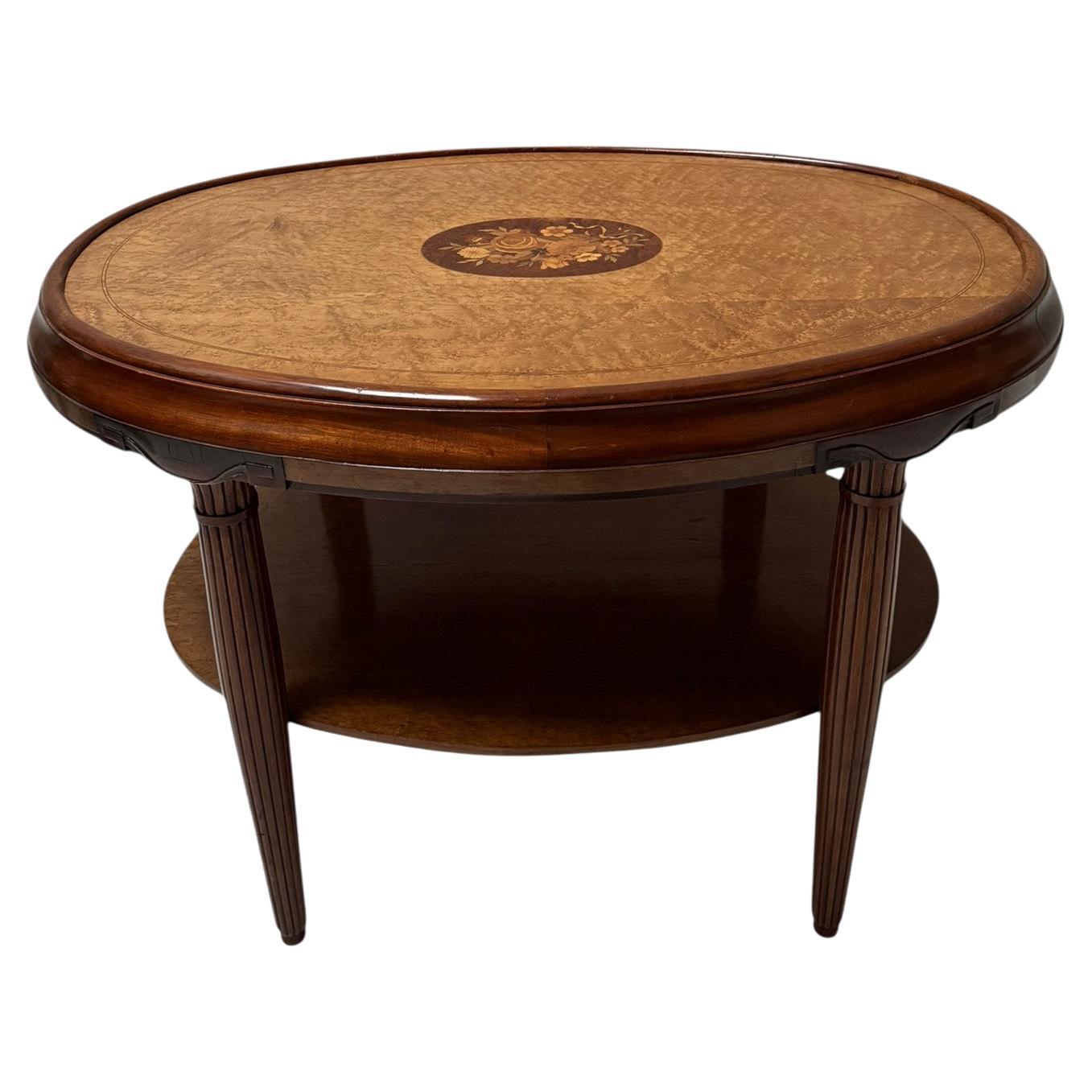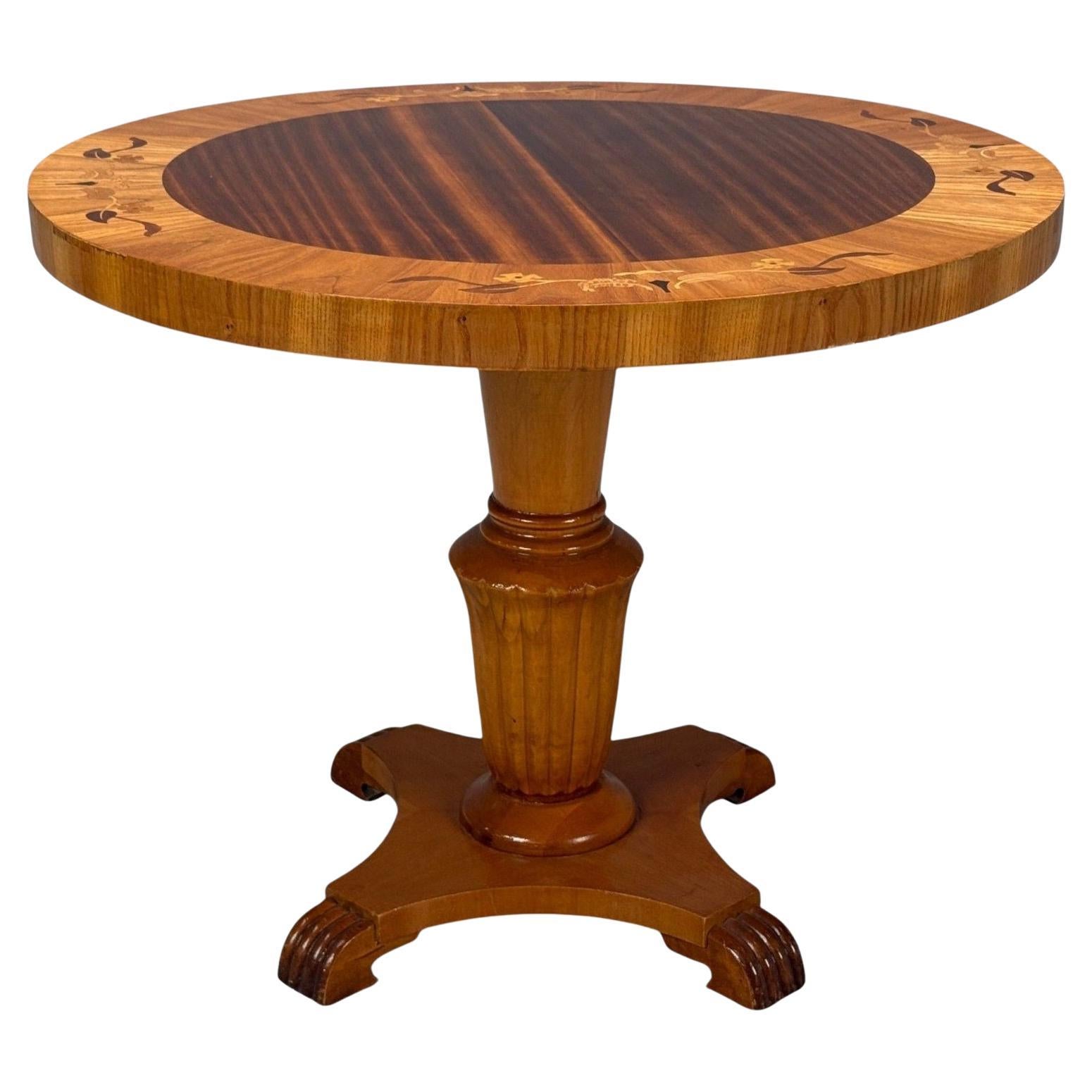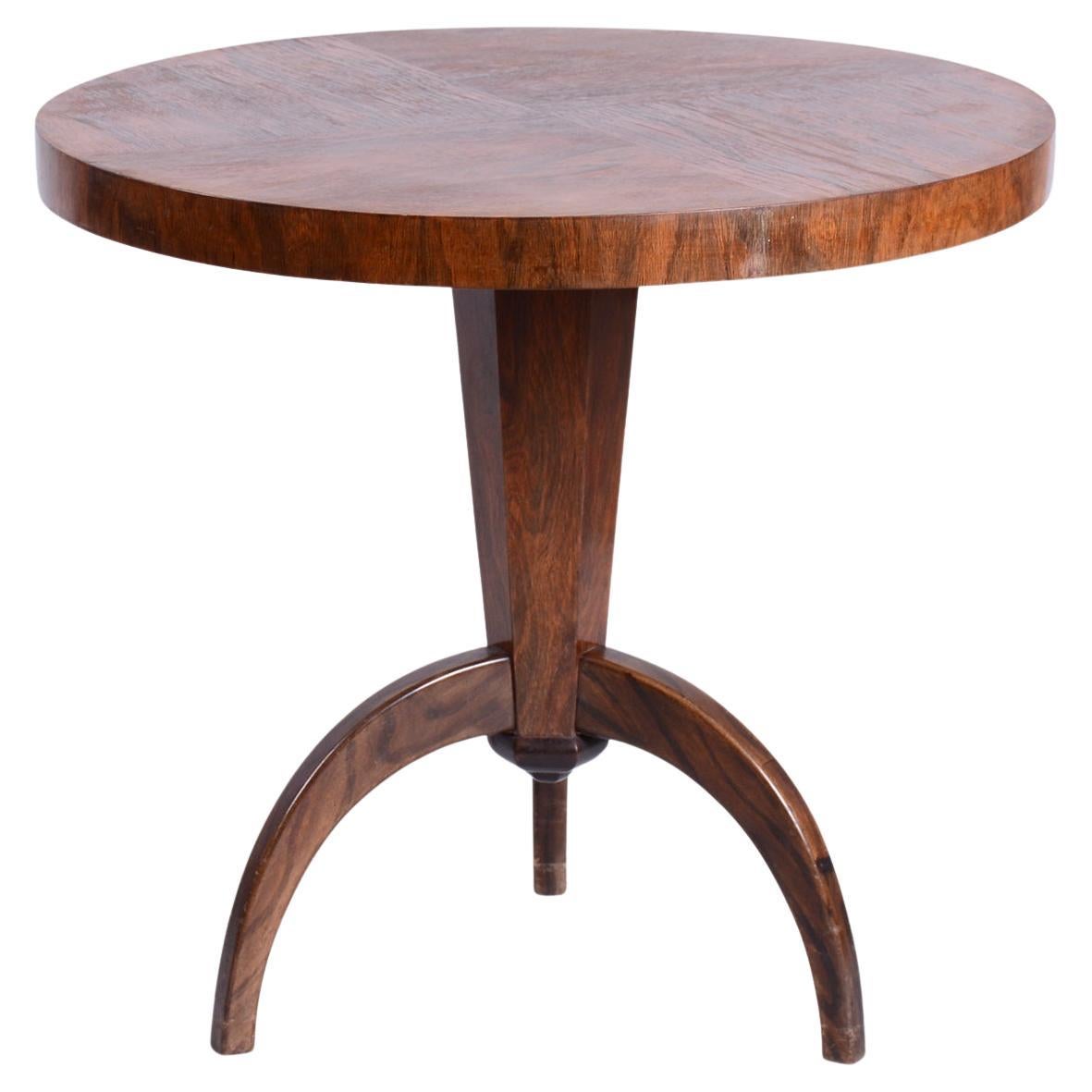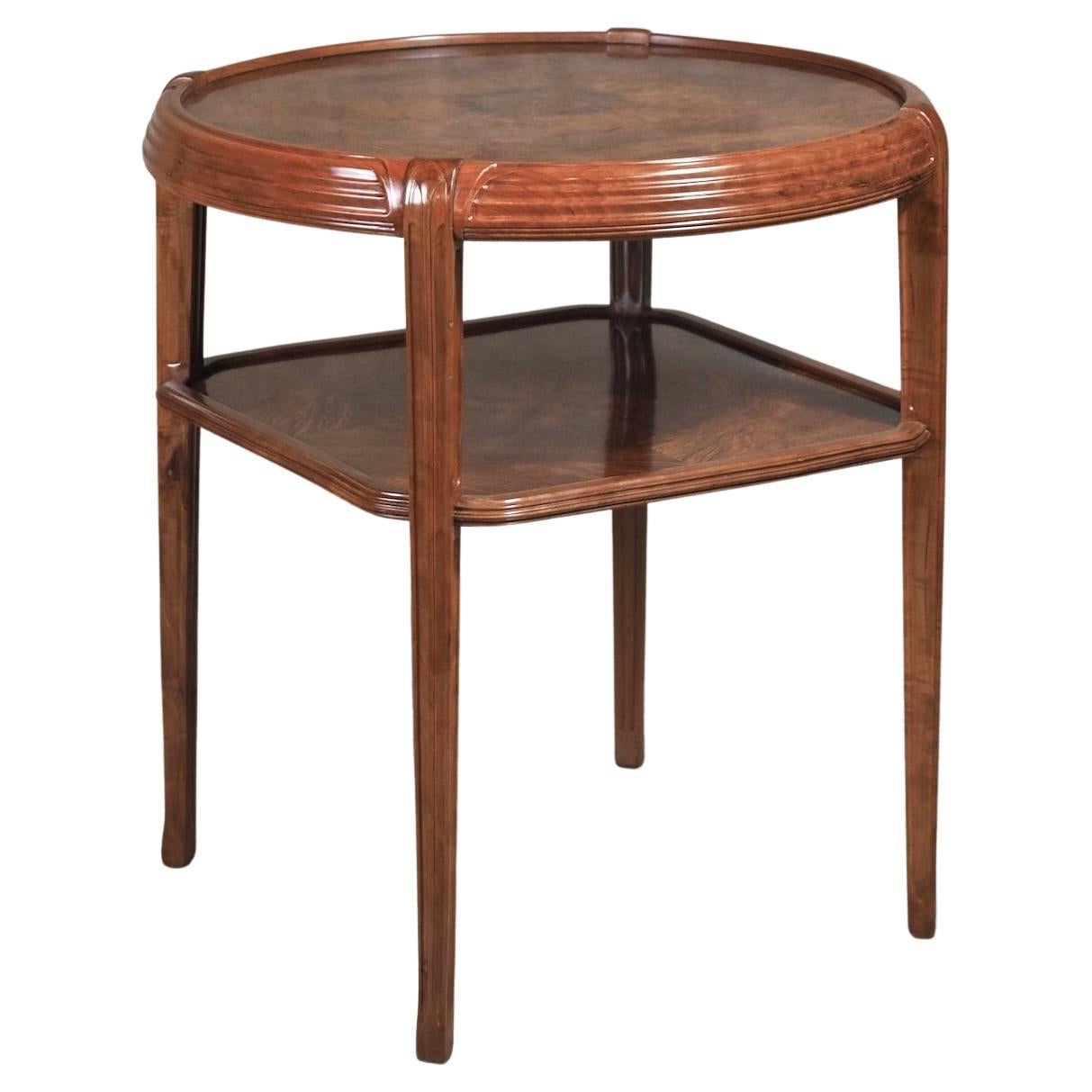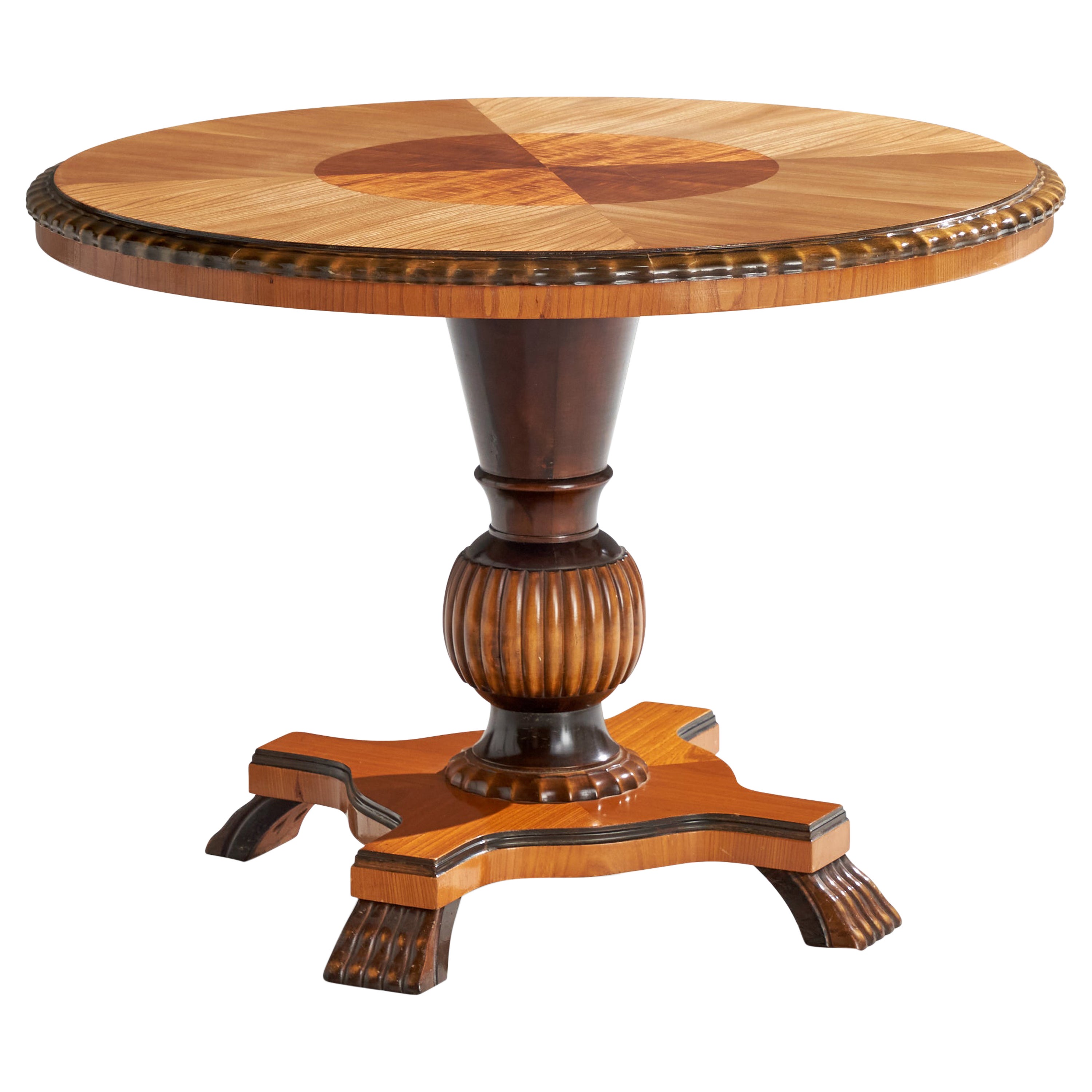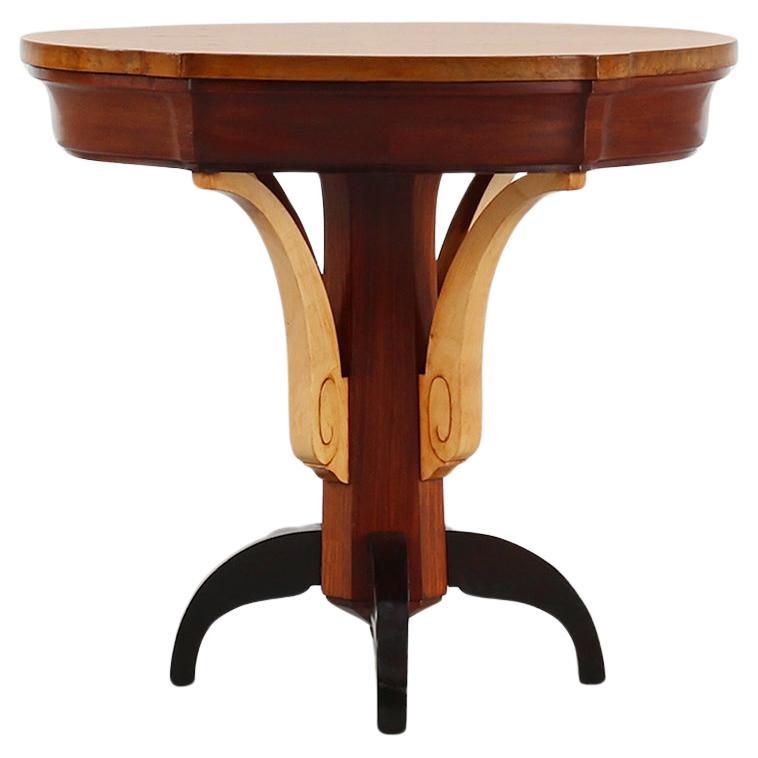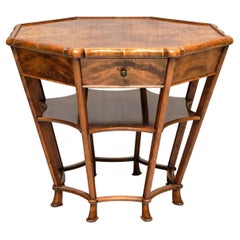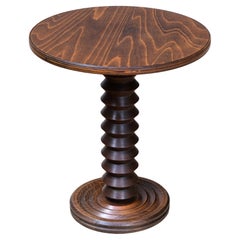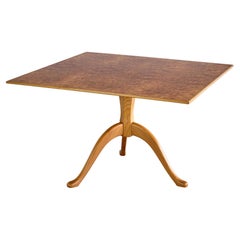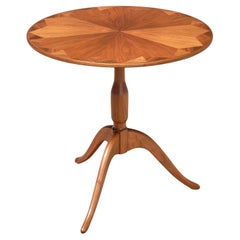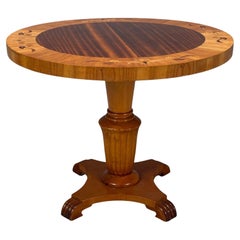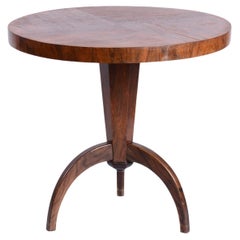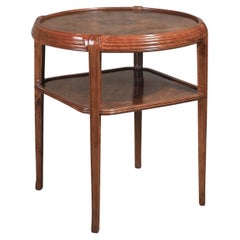Items Similar to Exceptional C.A. Lion Cachet Attributed Center Table, Oak and Macassar, 1920s
Want more images or videos?
Request additional images or videos from the seller
1 of 12
Exceptional C.A. Lion Cachet Attributed Center Table, Oak and Macassar, 1920s
$8,964.15
£6,703.49
€7,500
CA$12,358.77
A$13,564.05
CHF 7,128.11
MX$161,409.43
NOK 91,118.38
SEK 83,264.17
DKK 57,153.10
About the Item
This exceptional center table was produced in the Netherlands during the 1920s, most likely by the company H.P. Mutters & Zoon in The Hague, with the design attributed to Carel Adolphe Lion Cachet.
The striking design features a four-legged base and a round top crafted from a combination of solid oak and Macassar ebony. The circular oak top is refined with a thin round trim of Macassar, followed by a more substantial, contrasting band in solid Macassar. The contrast between the lighter oak and the darker Macassar, with its distinct grain, adds to the elegance of the design. The four outward-curved legs are beautifully carved and profiled, with detailed feet. Between each leg and the center of the table, a wavy lattice of solid Macassar is adorned with ocular-shaped cutouts, enhancing the table’s visual impact.
The originality of the design, paired with the high level of craftsmanship, makes this table a unique piece, suitable as either a center or large side table.
The table is in very good condition, with only very minor signs of wear consistent with age and use.
About C.A. Lion Cachet
Lion Cachet (1864–1945) is primarily associated with the Art Nouveau movement, though his work also reflects influences from the Arts & Crafts movement. His designs feature curvilinear forms, organic motifs, and elaborate decorative elements characteristic of Art Nouveau. At the same time, his emphasis on craftsmanship, high-quality materials, and traditional techniques aligns with the principles of the Arts & Crafts movement.
Cachet was also an important precursor to the Amsterdam School. His decorative approach, use of rich materials, and intricate detailing influenced this architectural and design movement. The Amsterdam School (active around 1910–1930) was known for its expressive, sculptural forms, rich ornamentation, and traditional craftsmanship—elements found in Cachet’s work. While he was not formally part of the movement, his ornamental and handcrafted style in furniture, bookbinding, and interior design helped pave the way for Amsterdam School designers.
In summary, Cachet’s work bridges Art Nouveau, Arts & Crafts, and the early Amsterdam School, solidifying his role as a significant figure in Dutch decorative arts.
- Creator:Carel Adolph Lion Cachet (Designer),H.P. Mutters and Zoon 1 (Cabinetmaker)
- Dimensions:Height: 25.79 in (65.5 cm)Diameter: 27.76 in (70.5 cm)
- Style:Art Deco (Of the Period)
- Materials and Techniques:
- Place of Origin:
- Period:
- Date of Manufacture:1920s
- Condition:Wear consistent with age and use.
- Seller Location:The Hague, NL
- Reference Number:1stDibs: LU1803343179472
About the Seller
5.0
Recognized Seller
These prestigious sellers are industry leaders and represent the highest echelon for item quality and design.
Platinum Seller
Premium sellers with a 4.7+ rating and 24-hour response times
Established in 2015
1stDibs seller since 2016
257 sales on 1stDibs
Typical response time: <1 hour
- ShippingRetrieving quote...Shipping from: Zwaag, Netherlands
- Return Policy
More From This Seller
View AllExceptional Expressionist Octagonal Center Table in Flamed Birch, Germany, 1920s
Located in The Hague, NL
This rare center table was produced in Germany in the late 1920s. Although the maker and designer remain unknown, the high level of craftsmanship and choice of material make this an exceptional occasional table.
The originality of the design perfectly illustrates the duality of the 1920s German Art...
Category
Vintage 1920s German Art Deco Center Tables
Materials
Wood, Birch
Charles Dudouyt Round Side Table in Solid Oak Wood, France, Late 1940s
By Charles Dudouyt
Located in The Hague, NL
This rare side table was designed by Charles Dudouyt and produced in France in the late 1940s. The different carved shapes of the wood illustrate the craftsmanship and originality of...
Category
Vintage 1940s French Brutalist Side Tables
Materials
Oak
Carl Malmsten 'Berg' Three Legged Coffee Table in Burl Elmwood, Sweden, 1960s
By Carl Malmsten
Located in The Hague, NL
This elegant side table was designed by Carl Malmsten and produced by his company in Sweden in the 1960s. This is a rare variant of his iconic 'Berg' model, with a larger square top ...
Category
Vintage 1960s Swedish Scandinavian Modern Tables
Materials
Elm, Burl
Carl Malmsten 'Båstad' Side Table in Mahogany, Erik Johansson, Sweden
By Carl Malmsten
Located in The Hague, NL
This elegant side table was designed by Carl Malmsten in 1951 and is known as the Båstad model, named after the town where Malmsten's close friend, the iconic textile artist Märta Må...
Category
Vintage 1950s Swedish Scandinavian Modern Side Tables
Materials
Wood
Bertil Söderberg Coffee/ Side Table in Burl Wood, Svensk Hemslöjd, Sweden, 1930s
By Svensk Hemslöjd, Bertil Söderberg 1
Located in The Hague, NL
This elegant coffee table was designed by Bertil Söderberg in the mid-1930s and produced by the Swedish company Svensk Hemslöjd. The design is defined by a sculptural, four-legged ba...
Category
Vintage 1930s Swedish Scandinavian Modern Side Tables
Materials
Birch, Elm, Burl
Bertil Söderberg Coffee/ Side Table in Burl Wood, Svensk Hemslöjd, Sweden, 1930s
By Svensk Hemslöjd, Bertil Söderberg 1
Located in The Hague, NL
This elegant coffee table was designed by Bertil Söderberg in the mid 1930s. It was produced by the Swedish company Svensk Hemslöjd.
The design is marked by the sculptural four legg...
Category
Vintage 1930s Swedish Scandinavian Modern Coffee and Cocktail Tables
Materials
Elm, Burl
You May Also Like
Art Deco French Walnut Center Table, 1930s
Located in Amsterdam, NL
Stunning and elegant Art Deco center table.
Striking French design from the 1930s.
Solid walnut frame with original Birdseye maple inlaid top.
There is a lower shelf for support and ...
Category
Vintage 1930s French Art Deco Center Tables
Materials
Birdseye Maple, Walnut
Swedish Art Deco, Marquetry Inlay, Wood, Center Table, Sweden, 1930s
Located in Manhasset, NY
Swedish Art Deco, Marquetry Inlay, Wood, Center Table, Sweden, 1930s
A Biedermeier style center table designed and produced in Sweden c. 1930s. Featuring a wonderful inlay top, pede...
Category
Vintage 1930s Swedish Art Deco Center Tables
Materials
Wood
Restored Art Deco Small Table, Oak, Revived Polish, France, 1920s
Located in Brandys nad Labem, Středočeský kraj
This elegant round Art Deco table comes from France from the first half of the 20th century. It is made of solid oak and veneered with exotic Bubinga (Kevazingo) veneer, which captiv...
Category
Vintage 1920s French Art Deco Coffee and Cocktail Tables
Materials
Wood, Lacquer, Oak
Leon Jallot Tiered Table in Pearwood and Camphor Burl
By Léon Jallot
Located in Philadelphia, PA
Early French Art Deco (transitional) tiered table by Leon Jallot in pearwood and camphor wood burl, circa 1910-12. 28” diameter x 29” high.
Leon Jallot (1874-1967)
Born in Nantes, July 24, 1874, Leon Jallot studied in Paris but did not go to any school of art. Without any formal training, other than a general refined sense of culture, he opened his own workshop at age 16 and began wood sculpting and making his own furniture.Strictly self-disciplined, he began as a wood carver. By 1899, at the age of just 24, he had worked his way to become Director of the Art Nouveau workshop of the collector, Siegfried Bing, for his shop called l’Art Nouveau in Paris. He remained there until 1901, overseeing production for the shop as well as Bing’s installation at the 1900 Paris Universal Exposition. Jallot therefore participated in the creation of some of the Art Nouveau movement’s most prized works – those designed by the firm’s renowned threesome: Georges de Feure, Eduoard Colonna, and Eugene Gaillard.
In 1901 Jallot became one of the founding members of the first Salon of Societe des Artistes Decorateurs – an organization which produced highly anticipated annual exhibitions through the first half of the 20th Century. In 1903 he established his own decorating workshop where he designed and fabricated furniture, fabrics, carpets, tapestries, glassware, lacqueer and screens.
Jallot was the first of the Art Nouveau designers to turn away from floral ornamentation and to pursue linearism – as early as 1904 his decoration was limited to the natural grain of the wood – and he was an advocate of rich materials rather than over-wrought forms to suggest luxury.
Jallot’s work was shown at the Salons of Societe Nationale des Beaux-Arts from 1908, Salon d’Automne from 1919, and at the SAD throughout. A review of his exhibit at the 1921 Salon des Artistes Decorateurs, in Art et Decoration, said:
“His furniture has the easy elegance of ideas created in a flash and then mulled over – ingenuity, savoir-faire, and patience are all combined in his work.”
He created furniture for the Grand Salon of Une Ambassade Francaise and Hotel du Collectionneur at the 1925 Paris Exposition Internationale des Arts Decoratifs et Industriels Modernes (which would, years later, launch the term “Art Deco”).
From 1921, Leon Jallot partnered with his son, Maurice (see Maurice Jallot’s biography elsewhere on the Calderwood Gallery...
Category
Vintage 1910s French Art Deco Center Tables
Materials
Wood, Pearwood, Burl
Swedish Designer, Side Table, Birch, Oak, Sweden, 1930s
Located in High Point, NC
A birch and oak side table designed and produced in Sweden, c. 1930s.
*done scratches and discoloration on legs, overall good vintage condition
Dimensions: 24.25” H x 33.25” diame...
Category
Vintage 1930s Swedish Art Deco Side Tables
Materials
Birch, Oak
Art Deco side table in wood, France ca. 1930
Located in Meulebeke, BE
France / 1930 / side table / wood / Art Deco
Stunning side table made in the 1930s in France, a period of artistic flourishing and innovation. This table combines a classic black ba...
Category
Vintage 1930s Art Deco Side Tables
Materials
Wood
More Ways To Browse
Lions Oak
Art Deco Macassar Side Table
Wavy Table
Lattice Table
Arts And Crafts Round Oak Table
Oak Lion Table
Black Lacquer End Table
Cast Table Leg
Coat Of Arms Wall
Concrete Table Top
Danish Modern Tray Table
Dovetail Table
Dutch Oak Table
Frederick Ii
French Art Nouveau Posters
French Dressing Mirror
French Iron Bistro Table
Henry Iv
